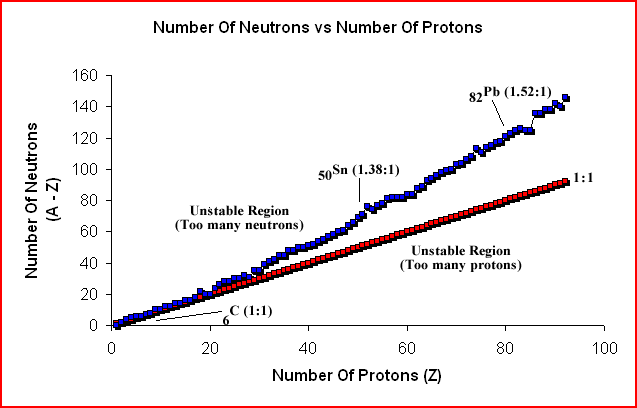Nuclear Stability
Atomic nuclei consist of positively charged protons and neutrons that are neutral. According to the laws of electrostatics, protons should repel each other and all nuclei should disintegrate. However, at very short distances of approxiamately 10-15 m, a strong nuclear force (a strong attractive force) exists between the nucleons (protons and neutrons).
There are many radioactive nuclei which disintegrate to form a smaller nucleus with one or more particles. An example is nitrogen-13 shown below.
137N ![]() 136C + 01e
136C + 01e
01e represents a positron.
The more protons that are packed in the small dense nucleus, the more neutrons are needed to provide the "nuclear glue". The graph below shows that lighter elements (up to about 20) have approxiamately equal numbers of protons and neutrons. However, the number of neutrons needed for stability increases more rapidly than the number of protons. The blue graph shows the nuclei that do not decay. The stable nuclei are said to reside in "belt of stability". As the number of protons in the nucleus increases, the ratio of neutrons to protons also increases to provide nuclear stability.
The empirical rules for governing the stability of a nucleus are given below.
- The neutron-to-proton ratio required for nuclear stability varies with atomic number. For the lighter elements (up to about 20), the ratio is close to 1:1 as indicated by both the red and blue graph segments. As the atomic number increases beyond 20, the ratio of neutrons to protons increase as indicated by the blue graph.
- All elements beyond 83Bi are radioactive.
- Nuclei with an even number of nucleons, protons and neutrons, are more stable than those with an odd number of nucleons.
- The unstable region resulting from a nucleus having too many neutrons (above the blue graph) undergoes spontaneous beta decay to become more stable.
- The unstable region resulting from a nucleus with too many protons (below the red graph) undergoes spontaneous positron decay or electron capture to become more stable. For the lighter nuclei, positron emission is favored and for the heavier nuclei, electron capture is favored.
- There are certain numbers of protons and neutrons that produce very stable nuclei. These numbers are referred to as magic numbers and are 2, 8, 20, 28, 50, 82, and 126. This behavior is similar to the magic numbers for atoms which are 2, 10, 18, 36, 54, and 86 (noble gas configuration).
